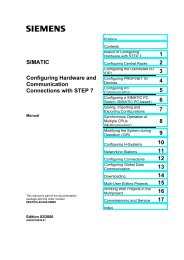II - DCE FEL ČVUT v Praze
II - DCE FEL ČVUT v Praze
II - DCE FEL ČVUT v Praze
Create successful ePaper yourself
Turn your PDF publications into a flip-book with our unique Google optimized e-Paper software.
Internal<br />
compensation<br />
Thermocouple<br />
connection<br />
options<br />
Abbreviations<br />
I/O Modules with Intrinsically-Safe Signals<br />
C79000-G7076-C152-04<br />
The following conditions must be observed:<br />
SIMATIC S7 Ex Analog Modules<br />
External compensation by means of a compensation box can only be<br />
carried out for one specific type of thermocouple. This means all channels<br />
of this module which operate with external compensation must be<br />
parameterized for the same type of thermocouple.<br />
Module diagnostic signals ”incorrect parameters in module” and<br />
”reference channel error” for the corresponding channels (0..5) in the case<br />
of incorrect parameterization.<br />
The parameters of a channel group apply to both channels of this channel<br />
group (e.g. type of thermocouple, integration time, etc.)<br />
For the purposes of internal compensation, you can form the reference<br />
junction at the terminals of the analog input module. In this case, you must<br />
route the compensating conductors to the analog module. The internal<br />
temperature sensor senses the terminal temperature of the module. The<br />
thermocouples (also different types) connected to the module are<br />
compensated with this temperature.<br />
Note<br />
For the analog input module SM 331; AI 8 x TC/4 x RTD, the compensation<br />
box is connected to terminals 18 and 19.<br />
The thermal resistor is connected to terminals 16, 17, 18 and 19 in order to<br />
register the reference junction temperature.<br />
Figs. 3-4 to 3-8 show the different connection options for thermocouples with<br />
external and internal compensation.<br />
The information provided in Section 3.2 on differences in potential UCM and<br />
UISO between the individual circuits still retains its validity.<br />
The abbreviations used in the Figs. 3-4 to 3-10 have the following<br />
significance:<br />
IC+ : Positive connection of constant current output<br />
IC- : Negative connection of constant current output<br />
M+ : Measuring conductor (positive)<br />
M- : Measuring conductor (negative)<br />
L+ : Power supply connection 24 V DC<br />
M : Ground terminal for 24 V DC power supply<br />
P5V : Supply voltage of module logic<br />
Minternal: Ground of module logic<br />
UV : Isolated supply voltage for compensation box<br />
3-27
















